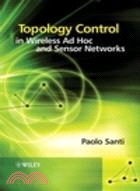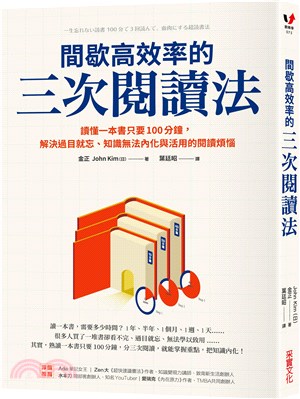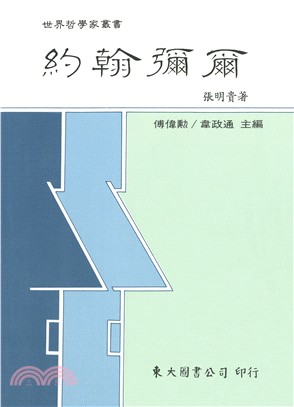Topology Control In Wireless Ad Hoc And Sensor Networks
- ISBN13:9780470094532
- 出版社:John Wiley & Sons Inc
- 作者:Santi
- 裝訂/頁數:平裝/280頁
- 出版日:2005/07/01
定 價:NT$ 6503 元
優惠價:90 折 5853 元
若需訂購本書,請電洽客服 02-25006600[分機130、131]。
相關商品
商品簡介
作者簡介
目次
商品簡介
Topology control is fundamental to solving scalability and capacity problems in large-scale wireless ad hoc and sensor networks.
Forthcoming wireless multi-hop networks such as ad hoc and sensor networks will allow network nodes to control the communication topology by choosing their transmitting ranges. Briefly, topology control (TC) is the art of co-ordinating nodes' decisions regarding their transmitting ranges, to generate a network with the desired features. Building an optimized network topology helps surpass the prevalent scalability and capacity problems.
Topology Control in Wireless Ad Hoc and Sensor Networks makes the case for topology control and provides an exhaustive coverage of TC techniques in wireless ad hoc and sensor networks, considering both stationary networks, to which most of the existing solutions are tailored, and mobile networks. The author introduces a new taxonomy of topology control and gives a full explication of the applications and challenges of this important topic.
Topology Control in Wireless Ad Hoc and Sensor Networks:
Defines topology control and explains its necessity, considering both stationary and mobile networks.
Describes the most representative TC protocols and their performance.
Covers the critical transmitting range for stationary and mobile networks, topology optimization problems such as energy efficiency, and distributed topology control.
Discusses implementation and 'open issues', including realistic models and the effect of multi-hop data traffic.
Presents a case study on routing protocol design, to demonstrate how TC can ease the design of cooperative routing protocols.
This invaluable text will provide graduate students in Computer Science, Electrical and Computer Engineering, Applied Mathematics and Physics, researchers in the field of ad hoc networking, and professionals in wireless telecoms as well as networking system developers with a single reference resource on topology control.
Forthcoming wireless multi-hop networks such as ad hoc and sensor networks will allow network nodes to control the communication topology by choosing their transmitting ranges. Briefly, topology control (TC) is the art of co-ordinating nodes' decisions regarding their transmitting ranges, to generate a network with the desired features. Building an optimized network topology helps surpass the prevalent scalability and capacity problems.
Topology Control in Wireless Ad Hoc and Sensor Networks makes the case for topology control and provides an exhaustive coverage of TC techniques in wireless ad hoc and sensor networks, considering both stationary networks, to which most of the existing solutions are tailored, and mobile networks. The author introduces a new taxonomy of topology control and gives a full explication of the applications and challenges of this important topic.
Topology Control in Wireless Ad Hoc and Sensor Networks:
Defines topology control and explains its necessity, considering both stationary and mobile networks.
Describes the most representative TC protocols and their performance.
Covers the critical transmitting range for stationary and mobile networks, topology optimization problems such as energy efficiency, and distributed topology control.
Discusses implementation and 'open issues', including realistic models and the effect of multi-hop data traffic.
Presents a case study on routing protocol design, to demonstrate how TC can ease the design of cooperative routing protocols.
This invaluable text will provide graduate students in Computer Science, Electrical and Computer Engineering, Applied Mathematics and Physics, researchers in the field of ad hoc networking, and professionals in wireless telecoms as well as networking system developers with a single reference resource on topology control.
作者簡介
Paolo Santi is Researcher at the Instituto di Informatica e Telematica del CNR in Pisa, Italy, a position he has held since 2001. He received the 'Laurea' Degree and the PhD in Computer Science from the University of Pisa in 1994 and 2000. respectively. During his career, he visited the School of Electrical and Computer Engineering, Georgia Institute of Technology, in 2001, and the Department of Computer Science, Carnegie Mellon University, in 2003.
During his PhD Studies, Dr. Santi's research activity focused on fault-tolerant computing in multiprocessor systems. Starting from 2001, his research interests shifted to wireless ad hoc networking, with particular focus on the investigation of fundamental network properties such as connectivity, network lifetime, and mobility modeling, and on the design of energy-efficient protocols.
Dr. Santi has contributed more than twenty papers in the field of wireless ad hoc and sensor networking, and has been involved in the organizational and technical committee of several conferences in the field. Dr. Santi is a member of ACM and SIGMOBILE.
During his PhD Studies, Dr. Santi's research activity focused on fault-tolerant computing in multiprocessor systems. Starting from 2001, his research interests shifted to wireless ad hoc networking, with particular focus on the investigation of fundamental network properties such as connectivity, network lifetime, and mobility modeling, and on the design of energy-efficient protocols.
Dr. Santi has contributed more than twenty papers in the field of wireless ad hoc and sensor networking, and has been involved in the organizational and technical committee of several conferences in the field. Dr. Santi is a member of ACM and SIGMOBILE.
目次
About the Author.
Preface.
Acknowledgments.
List of Abbreviations.
List of Figures.
List of Tables.
I: Introduction.
1. Ad Hoc and Sensor Networks.
1.1 The Future ofWireless Communication.
1.2 Challenges.
2. Modeling Ad Hoc Networks.
2.1 The Wireless Channel.
2.2 The Communication Graph.
2.3 Modeling Energy Consumption.
2.4 Mobility Models.
2.5 Asymptotic Notation.
3. Topology Control.
3.1 Motivations for Topology Control.
3.2 A Definition of Topology Control.
3.3 A Taxonomy of Topology Control.
3.4 Topology Control in the Protocol Stack.
II: The Critical Transmitting Range.
4. The CTR for Connectivity: Stationary Networks.
4.1 The CTR in Dense Networks.
4.2 The CTR in Sparse Networks.
4.3 The CTR with Different Deployment Region and Node Distribution.
4.4 Irregular Radio Coverage Area.
5. The CTR for Connectivity: Mobile Networks.
5.1 The CTR in RWPMobile Networks.
5.2 The CTR with Bounded, Obstacle-free Mobility.
6. Other Characterizations of the CTR 63
6.1 The CTR for k-connectivity.
6.2 The CTR for Connectivity with Bernoulli Nodes.
6.3 The Critical Coverage Range.
III: Topology Optimization Problems.
7. The Range Assignment Problem.
7.1 Problem Definition.
7.2 The RA Problem in One-dimensional Networks.
7.3 The RA Problem in Two- and Three-dimensional Networks.
7.4 The Symmetric Versions of the Problem.
7.5 The Energy Cost of the Optimal Range Assignment.
8. Energy-efficient Communication Topologies.
8.1 Energy-efficient Unicast.
8.2 Energy-efficient Broadcast.
IV: Distributed Topology Control.
9. Distributed Topology Control: Design Guidelines.
9.1 Ideal Features of a Topology Control Protocol.
9.2 The Quality of Information.
9.3 Logical and Physical Node Degrees.
10. Location-based Topology Control.
10.1 The R&M Protocol.
10.2 The LMST Protocol.
11. Direction-based Topology Control.
11.1 The CBTC Protocol.
11.2 The DistRNG Protocol.
12. Neighbor-based Topology Control.
12.1 The Number of Neighbors for Connectivity.
12.2 The KNeigh Protocol.
12.3 The XTC Protocol.
13. Dealing with Node Mobility.
13.1 TC Design Guidelines with Mobility.
13.2 TC in Mobile Networks: an Example.
13.3 The Effect of Mobility on the CNN.
13.4 Distributed TC in Mobile Networks: Existing Solutions.
V: Toward an Implementation of Topology Control.
14. Level-based Topology Control.
14.1 Level-based TC:Motivations.
14.2 The COMPOW Protocol.
14.3 The CLUSTERPOW Protocol.
14.4 The KNeighLev Protocol.
14.5 Comparing CLUSTERPOW and KneighLev.
15. Open Issues.
15.1 TC for Interference.
15.2 More-realistic Models.
15.3 Mobility and Topology Control.
15.4 Considering MultiHop Data Traffic.
15.5 Implementation of TC.
VI: Case Study and Appendices.
16. Case Study: TC and Cooperative Routing in Ad hoc Networks.
16.1 Cooperation in Ad hoc Networks.
16.2 Reference Application Scenario.
16.3 Modeling Routing as a Game.
16.4 A Practical Interpretation of Truthfulness.
16.5 Truthful Routing without TC.
16.6 Truthful Routing with TC.
16.7 Conclusion.
A: Elements of Graph Theory.
A.1 Basic Definitions.
A.2 Proximity Graphs.
B: Elements of Applied Probability.
Bibliography.
Index.
Preface.
Acknowledgments.
List of Abbreviations.
List of Figures.
List of Tables.
I: Introduction.
1. Ad Hoc and Sensor Networks.
1.1 The Future ofWireless Communication.
1.2 Challenges.
2. Modeling Ad Hoc Networks.
2.1 The Wireless Channel.
2.2 The Communication Graph.
2.3 Modeling Energy Consumption.
2.4 Mobility Models.
2.5 Asymptotic Notation.
3. Topology Control.
3.1 Motivations for Topology Control.
3.2 A Definition of Topology Control.
3.3 A Taxonomy of Topology Control.
3.4 Topology Control in the Protocol Stack.
II: The Critical Transmitting Range.
4. The CTR for Connectivity: Stationary Networks.
4.1 The CTR in Dense Networks.
4.2 The CTR in Sparse Networks.
4.3 The CTR with Different Deployment Region and Node Distribution.
4.4 Irregular Radio Coverage Area.
5. The CTR for Connectivity: Mobile Networks.
5.1 The CTR in RWPMobile Networks.
5.2 The CTR with Bounded, Obstacle-free Mobility.
6. Other Characterizations of the CTR 63
6.1 The CTR for k-connectivity.
6.2 The CTR for Connectivity with Bernoulli Nodes.
6.3 The Critical Coverage Range.
III: Topology Optimization Problems.
7. The Range Assignment Problem.
7.1 Problem Definition.
7.2 The RA Problem in One-dimensional Networks.
7.3 The RA Problem in Two- and Three-dimensional Networks.
7.4 The Symmetric Versions of the Problem.
7.5 The Energy Cost of the Optimal Range Assignment.
8. Energy-efficient Communication Topologies.
8.1 Energy-efficient Unicast.
8.2 Energy-efficient Broadcast.
IV: Distributed Topology Control.
9. Distributed Topology Control: Design Guidelines.
9.1 Ideal Features of a Topology Control Protocol.
9.2 The Quality of Information.
9.3 Logical and Physical Node Degrees.
10. Location-based Topology Control.
10.1 The R&M Protocol.
10.2 The LMST Protocol.
11. Direction-based Topology Control.
11.1 The CBTC Protocol.
11.2 The DistRNG Protocol.
12. Neighbor-based Topology Control.
12.1 The Number of Neighbors for Connectivity.
12.2 The KNeigh Protocol.
12.3 The XTC Protocol.
13. Dealing with Node Mobility.
13.1 TC Design Guidelines with Mobility.
13.2 TC in Mobile Networks: an Example.
13.3 The Effect of Mobility on the CNN.
13.4 Distributed TC in Mobile Networks: Existing Solutions.
V: Toward an Implementation of Topology Control.
14. Level-based Topology Control.
14.1 Level-based TC:Motivations.
14.2 The COMPOW Protocol.
14.3 The CLUSTERPOW Protocol.
14.4 The KNeighLev Protocol.
14.5 Comparing CLUSTERPOW and KneighLev.
15. Open Issues.
15.1 TC for Interference.
15.2 More-realistic Models.
15.3 Mobility and Topology Control.
15.4 Considering MultiHop Data Traffic.
15.5 Implementation of TC.
VI: Case Study and Appendices.
16. Case Study: TC and Cooperative Routing in Ad hoc Networks.
16.1 Cooperation in Ad hoc Networks.
16.2 Reference Application Scenario.
16.3 Modeling Routing as a Game.
16.4 A Practical Interpretation of Truthfulness.
16.5 Truthful Routing without TC.
16.6 Truthful Routing with TC.
16.7 Conclusion.
A: Elements of Graph Theory.
A.1 Basic Definitions.
A.2 Proximity Graphs.
B: Elements of Applied Probability.
Bibliography.
Index.
主題書展
更多主題書展
更多書展本週66折
您曾經瀏覽過的商品
購物須知
外文書商品之書封,為出版社提供之樣本。實際出貨商品,以出版社所提供之現有版本為主。部份書籍,因出版社供應狀況特殊,匯率將依實際狀況做調整。
無庫存之商品,在您完成訂單程序之後,將以空運的方式為你下單調貨。為了縮短等待的時間,建議您將外文書與其他商品分開下單,以獲得最快的取貨速度,平均調貨時間為1~2個月。
為了保護您的權益,「三民網路書店」提供會員七日商品鑑賞期(收到商品為起始日)。
若要辦理退貨,請在商品鑑賞期內寄回,且商品必須是全新狀態與完整包裝(商品、附件、發票、隨貨贈品等)否則恕不接受退貨。
























